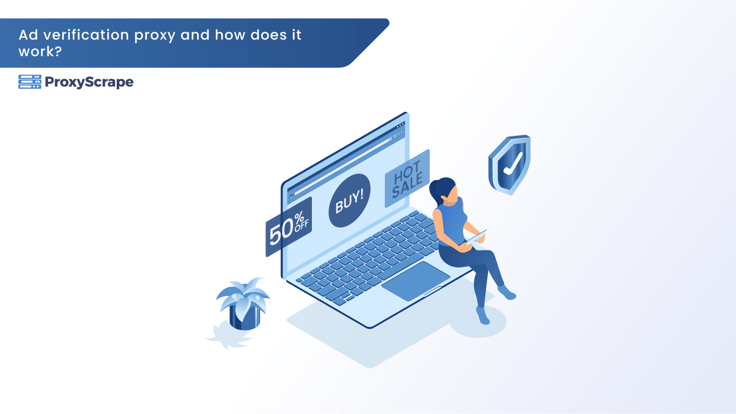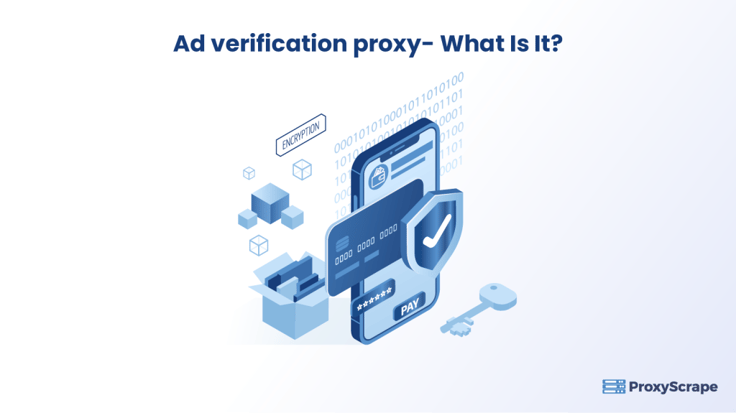Best Ad Verification Proxy and How Does It Works in 2025?

The term “ad fraud” may not bring that much importance to ordinary people, but it affects anybody who is a media consumer. In simple terms, “ad fraud” refers to the malpractice of not delivering suitable ads to the right people. Did you know that the global cost of ad fraud amounts to 65 billion U.S.
The term “ad fraud” may not bring that much importance to ordinary people, but it affects anybody who is a media consumer. In simple terms, “ad fraud” refers to the malpractice of not delivering suitable ads to the right people.
Did you know that the global cost of ad fraud amounts to 65 billion U.S. dollars? The most significant ad fraud market worldwide is the United States, according to Statista. The fraudulent act considerably reduces investors’ ROI (Return of Investment). We are moving into a digital world at a rapid rate. Our businesses are becoming more digital. Digital marketing has become a vast sector, with a market of 350 billion U.S. dollars in 2020, and it is projected to reach 786 billion U.S. dollars by 2026.
Digital marketing is a great way to attract international audiences. To reach wider audiences, ensure that your ads are displayed in the right place at the right time without compromising the quality of your ads. Fraudulent ad placement makes it difficult for digital marketers to get the best result possible from their ad campaigns.
This is where ad verification shines. Ad verification is a significant first step to fighting against ad fraudsters and getting the best results possible from your ad campaigns. In the upcoming block, we will discuss the ad verification proxy in detail and how it works efficiently against ad fraudsters.
Feel free to jump to any section to learn more about ad verification proxy!
How Does Ad Verification Work?
Ad Verification Proxy Server – What Is It?
Which Is the Best Proxy for Ad Verification Proxy?
The Best Proxy Provider for Your Ad Verification Proxy:
Ad Verification – What Is It?

Ad Verification Proxy
Ad verification is a process of checking if the ads are displayed in the proper context, on the right websites with the correct alignments, to deliver the right product to the right audience. This is because there are hundreds of ad formats and millions of websites, and there is no guarantee that end consumers will get to see the ad appropriately.
This is why businesses are turning to ad verification technology to check and monitor for inconsistency in their ads. With ad verification, you can see evident results, such as a viewer guarantee and a period spend-based model for your ad campaign.
How Does Ad Verification Work?
Advertisers mostly use ad verification technology to verify the design aspects of ads that match the specific requirements that the client requests in their ad campaign settings. Advertisers can alter these settings by using “verification tags.“
These verification tags are usually deployed with the ad as ad markup tags (HTML tags). The primary function of these tags is to scan the whole publisher’s website and make sure that the website is appropriate to deploy ads.
These verification tags collect data, such as content parameters, location of the website, and traffic data, and send it to the ad agency. They analyze the data to get a clear idea of where to place ads on the website to get maximum traffic and engagement.
Usually, the ad agency has a separate login structure and credentials from the ad verification companies. The primary purpose of having an ad verification company in your campaign is to keep an unbiased eye on your ad campaign and ensure that everything proceeds according to the plan.
Ad agencies and verification companies sometimes have a sophisticated demand-side platform (DSP). The demand-side platform is a software suite dedicatedly built for ad services. With the help of the DSP, advertisers can automate the whole process of buying advertising from the ad vendor.
The main objective of the DSP is to allow the mobile advertiser to buy high-quality ads and traffic without having much friction in the process. The function of DPS is that an advertiser uploads all the necessary information to set up the target audience and niche, then finally sets up the budget for their ad campaign. As a mobile advertiser, you can do all these processes with the help of the DSP’s dashboard.
Once the creative campaign details are uploaded, DSP automatically searches online (usually the ad networks) for sites and applications that match the setting of the client campaign and finally bit the budget for the ad placements.
Once the bid is resolved, DSP places ads on the website page and manages your campaign. The vital point is that the entire process takes place automatically in minutes, if not seconds.
DSP then sends the winning ad to the ad agency that will publish the ads with the help of the verification tag. The ad verification company collects the data with the help of the tag once the ad loads on the website page.
The ad verification company then passes the data with all the performance reports collected from the tag to the advertiser, including ad placement, traffic, engagement, clicks, and the overall health of the ads displayed on the webpage. Then, as an advertiser, you can track and monitor all the performance metrics of your ad’s reach in real-time.
It dramatically helps the advertisers by saving a lot of the budget in the ad campaigns and achieving peak efficiency without compromising the ad quality. It allows transparency between the publisher and the advertiser on how the publisher performs the site traffic and ensures that ads are published as instructed.
Ad verification technology assures the publisher that the published ads are authentic and appropriate. The publisher can check for various factors such as
- Malicious ads can hack your ad clicks and visibility using JavaScript code snippets to redirect customers to an inappropriate website when they click on the ad.
- Ad for banned products.
- Specific ads are restricted in some regions.
- A poorly constructed ad with misleading facts.
- Monitor click fraud manipulated traffic in the digital ads, fake impressions, and suspicious ads.
Usually, most companies focus on international ad campaigns to reach a broad, desired audience. To prepare for internal ad campaigns, you should have a localized ad QA process. Localized Ad verification is a crucial part of your campaign because it helps you personalize your ad based on the regions that you are targeting.
But one considerable difficulty involved in the localized ad QA process is access to different country ad websites. As mentioned, checking that your ads display per your requirements is essential. The only way to do that is to change your IP address using an ad verification proxy server and access your ad to verify your ad.
Ad Verification Proxy Server – What Is It?
An ad verification proxy or a proxy server is an intermediary server that sits between you (the client) and the target server (online).
When you connect online, your request will directly reach the target server and access the information. Your IP address is responsible for carrying your request to the target server, and based on your IP address, the target server will permit you to access the information. If restrictions are imposed on your region, the target server will reject your request and may even block your IP address. To bypass such filters, proxy dramatically helps you.
A proxy server reroutes your internet traffic through its server and passes your request to the target server. The process of rerouting helps you to mask your IP address and your physical location. This is a great way to trick the target server by saying that you are accessing the information from the desired location.
Which Is the Best Proxy for Ad Verification?
There are four types of proxies available online: Dedicated proxies, Residential proxies, Datacenter proxies, and Mobile proxies. Each proxy has a variety of uses. For example, datacenter proxies are best for high-speed online tasks, such as streaming high-quality videos from streaming services like Netflix and Amazon Prime. It would be best to choose proxies that resemble ISPs’ IP addresses for ad verification. Also, it will be a big help if proxies have rotating features to avoid IP blocking quickly. Using residential proxies for ad verification proxy is best for these requirements.
The Best Proxy Provider for Your Ad Verification:
ProxyScrape is one of the leading and most reliable proxy providers online. Three reliable proxy services include dedicated datacenter proxy servers, residential proxy servers, and premium proxy servers. You can use any proxy server based on your online tasks.
For example, a residential proxy server is the best option if you are performing web scraping. Since you need to make multiple requests, there is a good chance that the target server can block your IP address and render your web scraping efforts useless. A residential proxy helps you access data easily since its IP address resembles ISP’s IP address, and ProxyScrape’s residential proxy has a rotating feature.
With the rotating feature, your IP addresses dynamically change without needing external help, which in turn helps you mask your original IP address deeply. A dedicated datacenter proxy may be the best option if your work is related to high-speed tasks. You can rely on the datacenter proxy server for security purposes since it has many security layers, such as SSL and IP authentication.
Apart from that, the other features are: unlimited bandwidth with concurrent connections, dedicated US-based servers, IP authentication, and all proxies are HTTP proxies, meaning that all dedicated datacenter proxies can easily communicate with other target servers. Premium proxies are the same as dedicated datacenter proxies, the functionality remains the same, but the accessibility is different.
With dedicated datacenter proxies, the proxy list is private to only one user (you), but with premium proxies, the proxies are available to every user on ProxyScrape’s network. That is the reason why premium proxies cost less when compared to dedicated datacenter proxies.
In conclusion, the residential proxy is the best proxy for your ad verification proxy. The main reason is that it has a rotating feature; you can also change the country server by adding the country code during the username and password authentication process.
FAQs:
FAQs:
1. What is ad verification?
2. Which proxy is the best suited for ad verification proxy?
3. How does ad verification work?
Final Thoughts:
Ad verification is a powerful tool every digital advertiser should have in their arsenal. Ad fraud is becoming a threat to more businesses, and ad verification software is the best first step against ad fraudsters. Ad verification proxy provides many advantages, such as localized QA for your ads, real-time monitoring, and performance reports to improve your campaign and to hide your original IP address from the target to work efficiently. Get your residential proxy with ProxyScrape and deploy your ads safely and efficiently.